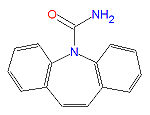Carbamazepine: Difference between revisions
Jump to navigation
Jump to search

imported>David E. Volk No edit summary |
imported>Robert Badgett (Added adverse effects and fixed external links.) |
||
| Line 50: | Line 50: | ||
*[[Timonil]]® | *[[Timonil]]® | ||
{{col-end}} | {{col-end}} | ||
==Adverse reactions== | |||
[[Toxic epidermal necrolysis]] (TEN) and [[Stevens-Johnson syndrome]] (SJS) may occur in patients with [[HLA]]-B*1502 allele who take carbamazepine.<ref>Anonymous. [http://www.fda.gov/cder/genomics/genomic_biomarkers_table.htm Table of Valid Genomic Biomarkers in the Context of Approved Drug Labels]. U.S. Food and Drug Administration</ref>. | |||
== External links == | == External links == | ||
{{ | {{CZMed}} | ||
== References == | == References == | ||
<references/> | <references/> | ||
Revision as of 12:34, 24 July 2008
|
| |||||||
| carbamazepine | |||||||
| |||||||
| Uses: | anticonvulsant | ||||||
| Properties: | |||||||
| Hazards: | |||||||
| |||||||
Carbamazepine is an anticonvulsant drug used to treat epilepsy, grand mal seizures and psychomotor or focal seizures, neurologic pain, as from trigenimal neuralgia, psychiatric disorders including manic-depressive illness and dementia related aggression. Its three-dimensional structure and action is similar to that of phentoin despite being quite dissimilar chemically. It is also similar to the tricyclic antidepressant medications.[1]
Brand names
Adverse reactions
Toxic epidermal necrolysis (TEN) and Stevens-Johnson syndrome (SJS) may occur in patients with HLA-B*1502 allele who take carbamazepine.[2].
External links
The most up-to-date information about Carbamazepine and other drugs can be found at the following sites.
- Carbamazepine - FDA approved drug information (drug label) from DailyMed (U.S. National Library of Medicine).
- Carbamazepine - Drug information for consumers from MedlinePlus (U.S. National Library of Medicine).
- Carbamazepine - Detailed information from DrugBank.
References
- ↑ Drug Bank page for Carbamazepine.
- ↑ Anonymous. Table of Valid Genomic Biomarkers in the Context of Approved Drug Labels. U.S. Food and Drug Administration
